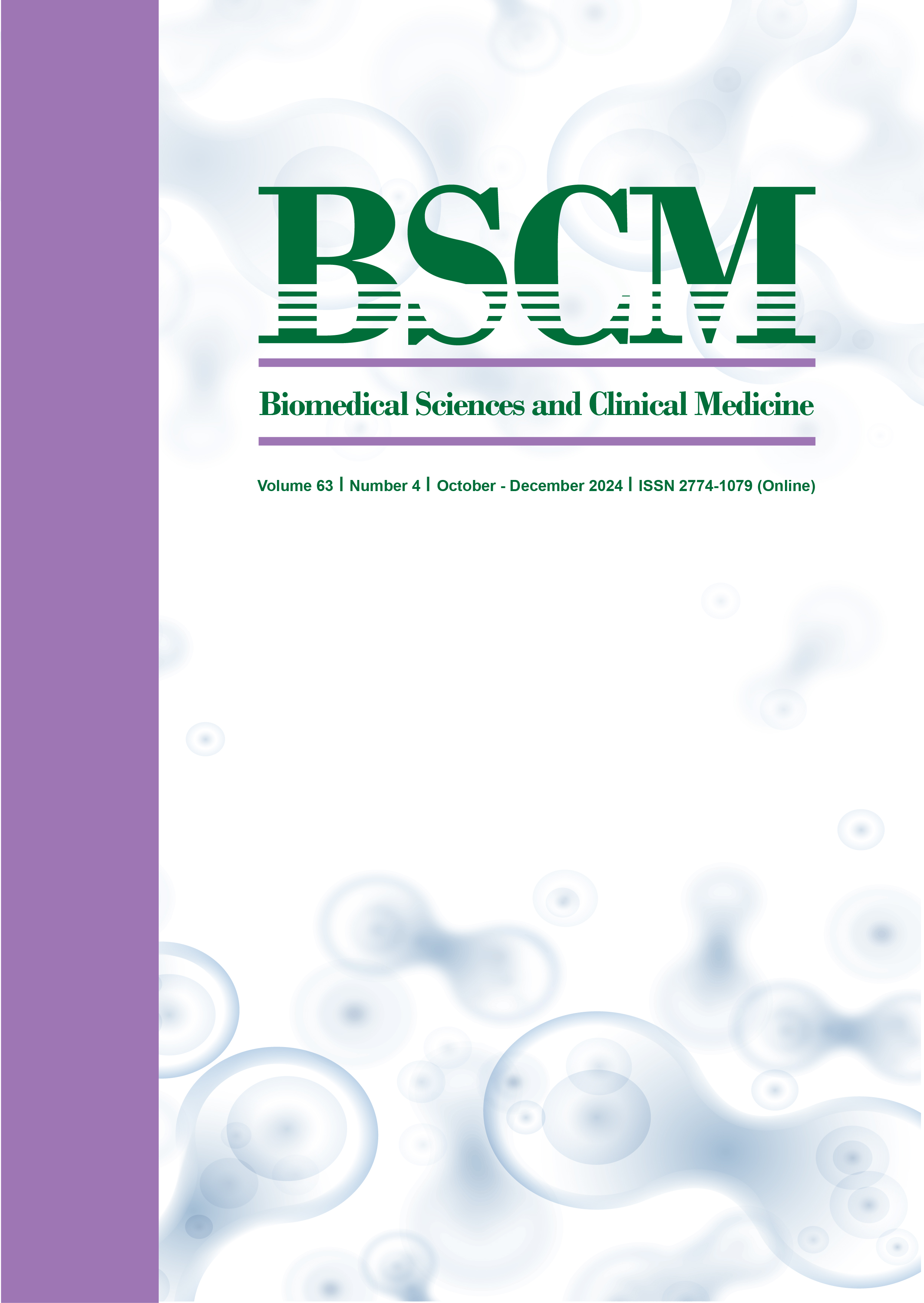Incidence of Cardiotoxicity Associated with The Use of Pegylated Liposomal Doxorubicin in Gynecologic Malignancies
Main Article Content
Abstract
Objective This study aims to evaluate the incidence of cardiotoxicity in patients with gynecologic cancer undergoing pegylated liposomal doxorubicin (PLD) treatment and to identify risk factors for developing changes in the left ventricular ejection fraction (LVEF).
Methods A retrospective analysis was conducted on patients with gynecologic malignancies who had received PLD treatment at Phramongkutklao Hospital from January 2013 through December 2022. Cardiotoxicity was defined as a confirmed diagnosis of congestive heart failure or a decline in LVEF of 10% or more. Spearman’s correlation and mixed modeling were used to analyze the relationship between patient factors and MUGA variations.
Results A total of 34 patients were included in the study. The median number of PLD cycles was six, with a median cumulative dose of 240 mg. No patient experienced doxorubicin-induced cardiotoxicity. Among the 19 patients with available pre- and post-treatment LVEF measurements, no significant decline in LVEF was observed following PLD (MD 6.6%, p = 0.124). However, Spearman’s correlation analysis revealed a negative correlation between high cumulative PLD doses (exceeding 1,500 mg) and LVEF change (coefficient = -0.53, p < 0.001). Mixed model analysis suggested a potential association between higher body mass index (BMI) and decreased LVEF post-treatment (β = -1.21, p = 0.036), while diabetes may be associated with improved LVEF outcomes (β = 12.18, p = 0.033).
Conclusions There were no cases of cardiotoxicity after PLD treatment. A potential association between higher BMI and decreased LVEF was found. A high cumulative PLD dose is correlated negatively with LVEF change. Cardiac monitoring is recommended for selected patients, particularly those who are obese or have received cumulative PLD doses exceeding 1,500 mg.
Article Details

This work is licensed under a Creative Commons Attribution 4.0 International License.
References
Abu-Rustum N, Yashar C, Arend R, Barber E, Bradley K, Brooks R, et al. Uterine Neoplasms, Version 1.2023, NCCN Clinical Practice Guidelines in Oncology. J Natl Compr Canc Netw. 2023;21:181-209.
Armstrong D, Alvarez R, Backes F, Bakkum-Gamez J, Barroilhet L, Behbakht K, et al. NCCN Guidelines® Insights: Ovarian Cancer, Version 3.2022. J Natl Compr Canc Netw. 2022;20:972-80.
Blank N, Laskov I, Kessous R, Kogan L, Lau S, Sebag I, et al. Absence of cardiotoxicity with prolonged treatment and large accumulating doses of pegylated liposomal doxorubicin. Cancer Chemother Pharmacol. 2017;80:737-43.
Theodoulou M, Hudis C. Cardiac profiles of liposomal anthracyclines: greater cardiac safety versus conventional doxorubicin? Cancer. 2004;100:2052-63.
Schwartz R, McKenzie W, Alexander J, Sager P, D’Souza A, Manatunga A, et al. Congestive heart failure and left ventricular dysfunction complicating doxorubicin therapy. Seven-year experience using serial radionuclide angiocardiography. Am J Med. 1987;82:1109-18.
Kesterson J, Odunsi K, Lele S. High cumulative doses of pegylated liposomal doxorubicin are not associated with cardiac toxicity in patients with gynecologic malignancies. Chemotherapy. 2010;56:108-11.
Skubitz K, Blaes A, Konety S, Francis G. Cardiac safety profile of patients receiving high cumulative doses of pegylated-liposomal doxorubicin: use of left ventricular ejection fraction is of unproven value. Cancer Chemother Pharmacol. 2017;80:787-98.
Kushnir C, Angarita A, Havrilesky L, Thompson S, Spahlinger D, Sinno A, et al. Selective cardiac surveillance in patients with gynecologic cancer undergoing treatment with pegylated liposomal doxorubicin (PLD). Gynecol Oncol. 2015;137:503-7.
Dioun S, Vilardo N, Goldberg G, Gressel G. Necessity of routine cardiac evaluation in patients receiving pegylated liposomal doxorubicin for gynecologic cancer. Gynecol Oncol. 2019;155:301-4.
Li X, Cheng X, Zhang G, Wang X, Huang J. Cardiac safety analysis of first-line chemotherapy drug pegylated liposomal doxorubicin in ovarian cancer. J Ovarian Res. 2022;15:96. PubMed PMID: 35971131.
Gill S, Savage K, Wysham W, Blackhurst D, Winter W, Puls L. Continuing routine cardiac surveillance in long-term use of pegylated liposomal doxorubicin: is it necessary? Gynecol Oncol. 2013;129:544-7.
Kaboré E, Guenancia C, Vaz-Luis I, Di Meglio A, Pistilli B, Coutant C, et al. Association of body mass index and cardiotoxicity related to anthracyclines and trastuzumab in early breast cancer: French CANTO cohort study. PLoS Med. 2019;16:e1002989. PubMed PMID: 31869400


